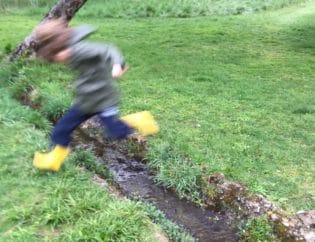
As parents, we want our kids to get as much nature time in as possible. But sometimes we don’t feel creative enough to set up a nature scavenger hunt for our kids. Or we just can’t get the kids (or their parents 🙂 to rise early enough for a family birdwatching walk. Maybe the weekend schedule is overbooked with activities and obligations and going on an all-day hike isn’t going to happen. That’s just a part of being a parent today. But it doesn’t mean that we should take time outside off of our “to do” list.
Because in fact, heading outside might just be the very thing our family needs. Nature can help us feel more creative, refreshed or less stressed. And we don't necessarily have to spend the entire weekend, full-day or even a full hour outside to get nature's benefits. You can get a quick fix from nature. In fact, researchers who study the benefits of nature on people continue to reduce the estimate on how much time we need to spend in nature in order to experience its benefits.
We pulled together a few ideas that can help provide a quick nature fix. Of course, the more time you spend out in nature, the better. But, this list should help whenever you can’t make a nature commitment.
Walk to school
 What if you could help your child start their school day off with a little more calmness and focus? Just a change in routine—from driving to walking—can help to do that. Nature is proven to give us a unique boost in calmness with the amazing added benefit of improved focus. Neuroscientists have found that the brain’s frontal lobe, the part of our brain that’s hyper-engaged in modern life, deactivates a little when you are outside while alpha waves, which indicate a calm but alert state, grow stronger. For examples of people who are great at engaging alpha waves, think Buddhist monks or mediators.
What if you could help your child start their school day off with a little more calmness and focus? Just a change in routine—from driving to walking—can help to do that. Nature is proven to give us a unique boost in calmness with the amazing added benefit of improved focus. Neuroscientists have found that the brain’s frontal lobe, the part of our brain that’s hyper-engaged in modern life, deactivates a little when you are outside while alpha waves, which indicate a calm but alert state, grow stronger. For examples of people who are great at engaging alpha waves, think Buddhist monks or mediators.
And then there are the added benefits of walking to school. One recent study, led by researchers from the University of Cambridge, looked at more than 2000 primary-age schoolchildren from across London and found that walking or cycling to school is beneficial for warding off obesity, a result which was consistent across neighborhoods, ethnicities and socioeconomic backgrounds.
Go on a 20-minute walk (& sitting breaks are fine!)
 According to a study by University of Michigan researchers, 20 minutes spent walking, sitting or completing a physical activity outside or interacting with nature can reduce health issues such as chronic stress, blood pressure, cholesterol, heart disease and weight. And even better, if you bump that up to between 20 and 30 minutes, cortisol levels drop at their greatest rate. After that, de-stressing continues, but more slowly.
According to a study by University of Michigan researchers, 20 minutes spent walking, sitting or completing a physical activity outside or interacting with nature can reduce health issues such as chronic stress, blood pressure, cholesterol, heart disease and weight. And even better, if you bump that up to between 20 and 30 minutes, cortisol levels drop at their greatest rate. After that, de-stressing continues, but more slowly.
This is why a family walk outdoors may a perfect antidote to brain fog before homework time or to prevent your kids from going into screen mode autopilot. A walk in nature can serve as a “reset” —lightening moods and clearing minds. And a family nature walk doesn’t have to be ambitious. In fact, it’s best kept simple. You don’t need to research the best trail or the least discovered natural area. And while you can certainly head out to the nearest park, you can simply take a walk in your neighborhood. Really, all you need is a sidewalk or a safe path to walk on and some nature along the way.
Take a 5-minute time out

Ok, so you don’t have 20 minutes. You’re in luck because researchers leading a study published in the Journal of Positive Psychology found that people who spent just five minutes sitting in nature experienced an increase in positive emotions. Interestingly, the researchers found that increasing the duration of the time spent in nature did not increase the number of positive emotions experienced, however, negative emotions were lowered in both settings with five minutes of rest.
“There are two important take-homes; the first I emphasize to all my students these days — when you need an emotional boost, the fastest and easiest way is to spend a few minutes with nature,” one of the study’s authors, Katherine D. Arbuthnott, told PsyPost.
Head to the zoo
 Kids love to visit zoos to learn more about wildlife and conservation. But visiting a zoo can also reduce their stress levels! For a recent study by the Detroit Zoological Society and Michigan State University, study, participants were hooked up to electrodes in a lab, given a verbal math test and then asked to deliver a speech off-the-cuff. The participants were separated into three groups and showed a video of either a plain white screen, Detroit traffic or animals at the Detroit Zoo. The scientists then measured stress indicators, such as heart rate, skin conductance, and facial reaction. The results showed that stress levels were lowest in the group who were shown animals. So, just viewing animals reduces stress levels—a bonus for you and your kids.
Kids love to visit zoos to learn more about wildlife and conservation. But visiting a zoo can also reduce their stress levels! For a recent study by the Detroit Zoological Society and Michigan State University, study, participants were hooked up to electrodes in a lab, given a verbal math test and then asked to deliver a speech off-the-cuff. The participants were separated into three groups and showed a video of either a plain white screen, Detroit traffic or animals at the Detroit Zoo. The scientists then measured stress indicators, such as heart rate, skin conductance, and facial reaction. The results showed that stress levels were lowest in the group who were shown animals. So, just viewing animals reduces stress levels—a bonus for you and your kids.
Take your conversation outside
 What parent hasn’t suffered the blank stare or a one-syllable response to the question: “how was your day?” If you really want to find out how your child’s day went, take it outside.
What parent hasn’t suffered the blank stare or a one-syllable response to the question: “how was your day?” If you really want to find out how your child’s day went, take it outside.
Being outside in nature eases stress and creates a more positive mood for both children and adults, creating a better atmosphere for easier conversation
But of course, researchers have looked more deeply. Researchers from the University of Manchester and Cardiff University analyzed conversations between parents and their young kids when they explored a city park as well as an indoor education center. After reviewing conversations between parents and their 3- and 4-year-olds, the researchers noted "significant" improvement in conversations held outside. They found that their communication was much more "responsive and connected" when they were outdoors versus when they were talking inside.











